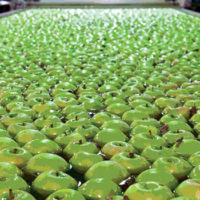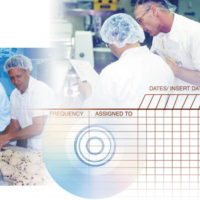SOPs Spell Out Procedures and Expectations

Cleaning and sanitation activities are at the heart of food safety: Food manufacturing equipment must be clean of product residue as well as bacteria, else we place our customers and consumers at risk with allergens, pathogens or other forms of cross-contamination. Additionally, while we may not like to be “told” how to do our job(s), in our industry it is necessary that certain tasks—including cleaning and sanitation activities—be directed by written procedures.
Many quality codes, including Safe Quality Food and other recognized standards, as well as those of the U.S. Food and Drug Administration (FDA) or U.S. Department of Agriculture, have written instructions in place to direct food company employees in their jobs. These quality codes or government agencies have no mandated format or content for written instructions—often called Standard Operating Procedures (SOPs), or for sanitation, SSOPs.
Just What Is an SOP?
Where a batch production record can be compared to a recipe, an SOP is an instruction manual on how to execute a certain task. An SOP should contain the following: chronological step-by-step instructions; information on specific tools or equipment, including chemicals and safety equipment required for the task at hand; who is specifically responsible for completing the task; specific parameters such as times, temperatures and duration of events; and the required means of documenting the task’s completion. It should detail the work in a manner that is instructive to and easily understood by an employee, but also informative to an inspector or auditor.
SOPs—or SSOPs—can be task specific or administrative in nature and format. A “task-specific” SOP is typically a set of instructions for a particular job, like operating or cleaning a piece of equipment or how to conduct a laboratory test. An “administrative” SOP is typically a set of instructions for navigating through or an explanation of a firm’s business and quality systems. While SOPs are typically very instructive documents, an administrative SOP can be more narrative and/or descriptive in nature and format.
Carefully written SOPs should ensure that each time a particular task is done, the work is done in a specific, prescribed manner and sequence, regardless of who does it. The results of such work, completed by any assigned and trained employee, should be readily comparable from person to person, ensuring consistency of outcome. This is paramount in cleaning and sanitation tasks; these need to be completed in a repeatable and thorough manner, and steps should always follow a prescribed sequence (e.g., clean, then sanitize, using proper-strength chemicals in each instance). Well-written SOPs are useful in teaching new employees the correct, and uniform, method of doing a job—and these written procedures can help veteran employees learn new skills as well as serve as reminders for tasks that are not undertaken very frequently.
Consider this example. A sanitation worker is given the following instructions: Clean the soup-mixing tank’s removable agitator assembly in mild detergent, rinse and dry before reinstalling and using the tank.
What was expected when this instruction was written was that someone would make up a quantity of cleaning solution at the proper detergent concentration, immerse the agitator assembly in the cleaning solution and agitate it until visibly free of product residue, run the agitator assembly under a stream of water until visibly free of detergent and set it on the drying rack to dry. In the next batch of soup, a soapy film was noticed on the surface of the tank’s contents and tiny blue fibers were floating in the product as well.
What the worker did was make up a bucket of cleaning solution. However, he used too much powdered cleaner, which did not dissolve. Then he rinsed the agitator assembly, not by running it in a stream of water but by merely soaking it in a second bucket that contained water. Instead of letting it air-dry on a drying rack, he helped it along by wiping it with a towel!
Maybe this is how the instruction should have been written: Collect 10 gallons of water in a clean container at 100 °F; add 10 ounces of powdered XYZ detergent and, with a clean paddle, stir to dissolve; immerse the agitator assembly and, by hand, agitate it in the solution until product residue appears to be removed; remove the valve assembly and rinse it under a stream of running water until it is visibly free of product and detergent; set the valve on a drying rack in the “cleaned equipment” section and allow to air-dry; document the cleaning using an equipment-status tag.
SOPs or SSOPs are different from policies or standards. The latter are prescriptive, descriptive and set an expectation: “…each plant shall maintain storage areas in a hygienic condition....” SOPs or SSOPs are instructive, directive and are written to contain actions around a task—likely intended to fulfill a policy’s requirements.
Now consider this example. A manufacturing or cleaning process begins with raw materials and/or ingredients, follows certain specific steps and stages as it progresses, requires actionable events to move it forward or events as it progresses and has an endpoint, such as an intermediate substance or finished product, or a clean manufacturing line, which is usually measurable (e.g., a finished product test). A written instruction begins with raw materials, such as data, words and graphics, follows a logical progression of steps or events to reach a stopping point and should have a measurable endpoint (e.g., a successful preoperative inspection).
SOP Preparation
As you prepare to draft an SOP or SSOP, take into account the following:
• What endpoint must be achieved?
• What definitive activities or tasks must occur?
• What tools will be needed to execute the task? How will it be known that the task is successfully complete?
• What processing equipment is involved or will impact the task execution?
• Who is responsible for executing the task(s) or following the procedure?
• In what order must these tasks occur in order to succeed?
• How should the steps be executed and the endpoint achieved be documented?
As you actually compose the document:
• Write down major events and activities that need to happen to get the entire task done
• Organize them in the order these steps need to happen
• Make a diagram with words and arrows
• Assign or identify task responsibilities
• Include information on equipment, chemicals or tools needed to successfully execute the task
Remember, an SOP or SSOP is an instruction, not a story. Avoid the following when writing an SOP or SSOP:
• Too much detail; too many words; long sentences
• Too little detail; choppy, short sentences
• What gets done, not what is done
• What is done, but not how to do it
• Tasks not in chronological order and responsibility not clearly defined
• Equipment and tools involved not identified
• Assumptions
SSOPs should include, but not necessarily be limited to, the following information: chemicals, concentrations and temperatures needed to clean a certain food manufacturing machine; personal protective equipment that should be worn while handling the chemicals; machine disassembly instructions; the exact sequence in which the machine should be cleaned; at what temperature and for how long solutions should be applied; postcleaning and sanitation inspections; task frequencies and documentation requirements.
Cleaning and sanitation rank-and-file staff should be involved in preparing SSOPs. These workers are really the “experts” in the particular job. Workers who write and follow these written procedures are the real force in a factory that helps ensure food safety. The consistent, predictable and repeatable cleaning and sanitation of food manufacturing equipment results in a product safe from cross-contamination with allergens or microbes. Remember to say what you do, do what you say and document what you did.
Michael Barazia has worked in various quality and regulatory compliance positions in the food and nutritional industry for 11 years and holds B.S. and M.S. degrees in biology. He can be reached at mbarazia@bluebunny.com.
>
Looking for a reprint of this article?
From high-res PDFs to custom plaques, order your copy today!





